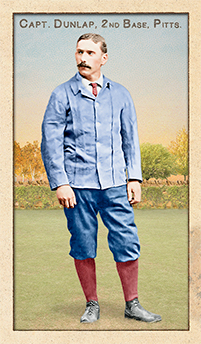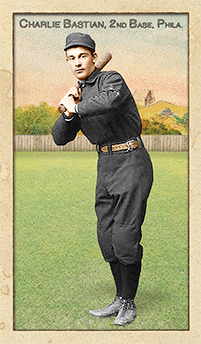- Series: Beginnings: 1880's
- City: Pittsburgh
- Team: Alleghenys
- League: National League
Frederick C. Dunlap (1859-1902) strode the heights of baseball throughout the 1880s as the “king of second basemen.” Highest-paid, adored by fans, sought by clubs who needed to win, the slick-fielding, sharp-eyed batsman could write his own ticket, and did. When Detroit (which had paid a record price to secure him from St. Louis) wanted to sell him to Pittsburgh, “Sure-Shot” demanded and nearly got half the proceeds. Despite never using a glove, this graceful fielder consistently ranked as the best at his position. In 1910, the founder of The Sporting News said he had seen them all and Dunlap was “the greatest that ever lived.” Yet his fall equaled his rise: forced out by a broken leg, a decade later his fortune was gone, as were his friends and health. “King Fred” died in 1902 “clean broke” without enough to carry his coffin.
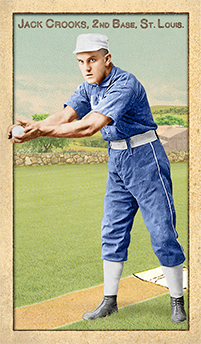
- Series: Beginnings: 1880's
- City: St. Louis
- Team: Whites (WA)
- League: Western Association
Charles John Crooks (1865-1918) became the first player in organized ball known to have hit four home runs in a game, accomplishing the feat for the Omaha Omahogs in 1889. The whole Western League had struggled to stay afloat that year and the team’s sale of Crooks to the American Association’s Columbus Colts that summer enabled them to make a profit (Omaha got $1750 for their outfielder and netted $1000 for the year). The four homers proved his strength but it was Crooks’ uncanny ability to draw walks that made him most valuable. He remains among a handful of players to record more bases on balls than games in a season, ranking him with the likes of Ted Williams, the Mick and the Babe. With a lifetime OBP of .408 and a BA of .237, Jack is in the top-ten highest ratio of the two.
- Despite Jack’s sabermetric value, the 1890 Colts were his only winning team in an 8-year career
- Jack cut short his baseball career after finding success as a cigar salesman
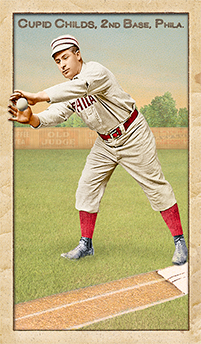
- Series: Beginnings: 1880's
- City: Philadelphia
- Team: Quakers
- League: National League
Clarence Algernon Childs (1867-1912) was not only a fine second-baseman, he was an excellent batsman with a knack for getting on base. He played 13 seasons in the majors for five clubs. His best years were the eight he spent with the Cleveland Spiders where he played alongside Cy Young, Jesse Burkett, Bobby Wallace, Buck Ewing, George Davis and John Clarkson. Never elected to the Hall of Fame, Cupid’s on-base percentage exceeds that of every second-baseman in Cooperstown but Rogers Hornsby and Eddie Collins and his lifetime .306 average is better than a dozen who made it in. The stocky Childs was dubbed “the dumpling” by a Grand Rapids reporter describing his tryout with Kalamazoo in 1888. Yet, the article said Cupid could cover more ground than most. His arrival in Cleveland resulted from a favorable ruling in a nationally publicized case when the Orioles tried to hold him to a contract ruled null. Childs fit in well with Patsy Tebeau’s “hooligans” through the 1890s.
- Ranks 24th all-time in OBP (.416), just behind Stan Musial
- Had a great eye at the plate, striking out only once every 26 at bats
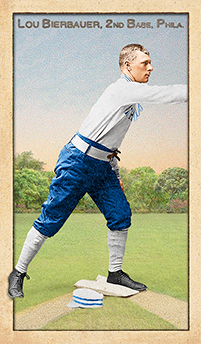
- Series: Beginnings: 1880's
- City: Philadelphia
- Team: Athletics (AA)
- League: American Association
Louis W. Bierbauer (1865-1926) was the treasure, buried then in the snows of Lake Erie, who gave his beloved Pittsburgh team its new name. Ned Hanlon was the privateer who braved the icy waters of Presque Isle in winter to sign the second-baseman away from the Athletics. This “piratical” act became so celebrated it gave the Alleghenys their permanent identity. Louie had done very well by the Athletics’s for his first four years in MLB. His year in the Players’ League with Ward’s Wonders was equally effective, causing the canny Hanlon to seize on Philadelphia’s lapse (they had not “reserved” Bierbauer). Lou rewarded his new club with six fine years at second base. Over his 13-year career, Lou would hit .267 with a .656 OPS. His performance stumbled a bit after joining the Pirates, but Bierbauer remained a strong hitter and defender through the 1896 season.
- Per Sporting Life in ’89: “Bierbauer is undoubtedly the king-pin second-baseman of the [American] Association”
- Ended his major league tenure in 1898 but continued in the minors. Lou managed the Canadian League’s St. Thomas Saints in 1915, his final year in pro ball
- Series: Beginnings: 1880's
- City: Philadelphia
- Team: Quakers
- League: National League
Charles J. Bastian (1860-1932) was the model “good field, no hit” infielder, squeezing 4 different leagues and 6 teams into his 8 year career. He started in MLB with the Wilmington Quicksteps of the evanescent Union Assoc’s only year, 1884, and finished with a game in the Players’ League in 1891.
- Lifetime BA of .189 defeated his finesse in the field
- Led all NL second-basemen in fielding % in 1886
- His main club was the Quakers, who were the Phillies when Bastian returned for one game in ‘91
